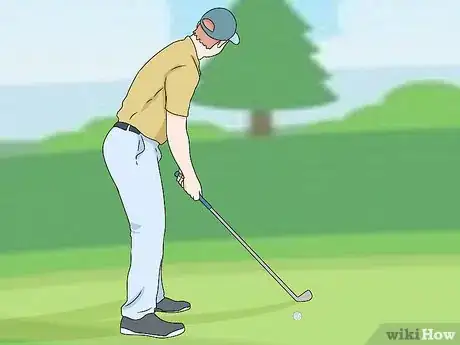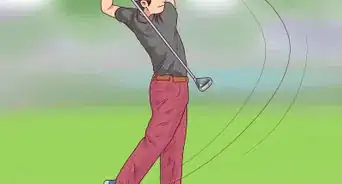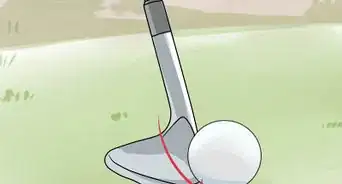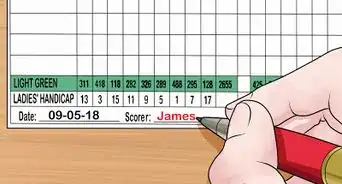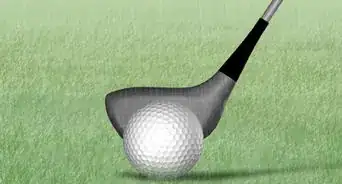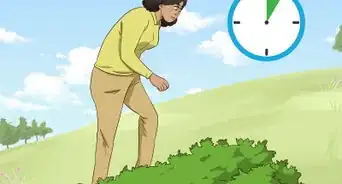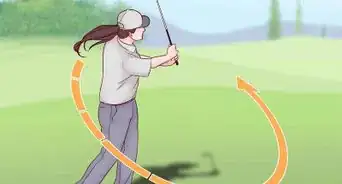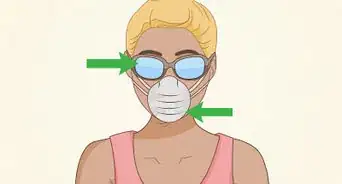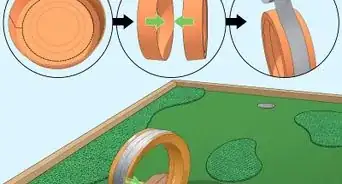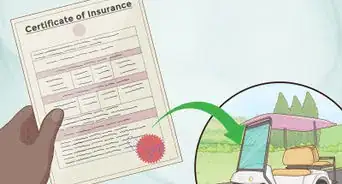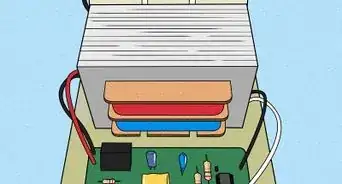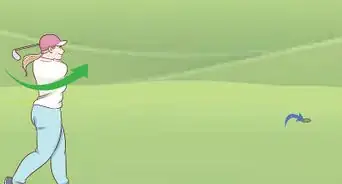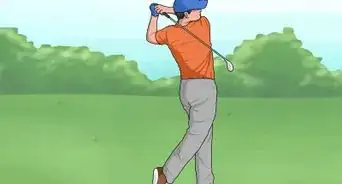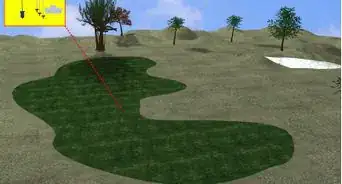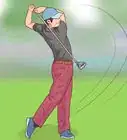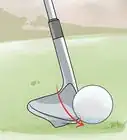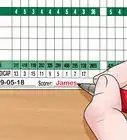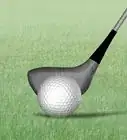This article was co-authored by Michael Metz. Michael Metz is a Golf Instructor and the Director of Instruction at Simi Hills Golf Course. With more than 15 years of experience, Michael is adept at coaching all facets of Golf. Mike uses technology, such as Flightscope, V1 Swing Suite, Blast Motion, and BodiTrak pressure mapping, to provide advanced golf training with quick results.
There are 16 references cited in this article, which can be found at the bottom of the page.
This article has been viewed 30,106 times.
It takes a lot of time and practice to become an expert golfer. Practice can take place at the driving range, the golf course, or at home. Take a well-rounded approach to improving your golf game by working on your short game, long drives, and mental approach to the game. Being consistent and having a good attitude will help be on your way to being a better golfer.
Steps
Improving Your Short Game
-
1Work on your putting skills. The quickest way to improve your score is to work on your short game. If you do not have a lot of time to practice, spending time on your short game is better than spending time hitting long balls.[1] Putting is very important aspect of your short game.
- Place ten balls in a circle, three feet from the hole. Move around the circle and try to sink all of the puts. Try to sink ten putts in a row. If you miss one, start over.
- Try to practice your putting for fifteen minutes each day. The better you become at putting the more your confidence will increase.[2]
- You can also start off with two-foot putts and then graduate to three-foot putts.
-
2Use soft hands when you chip. Lightly grip the club to decrease the tension in your arms. Place more weight on your front foot, use your arms and shoulders to swing the club back, and swing downward by pushing your right knee towards your target. Your left wrist should be flat throughout the entire motion.[3]
- The swing is very short so your right elbow should never be behind your body.
- The shaft of the club should always be in line with your left arm. Your left arm controls your chipping swing.[4]
- Rotate your body forward as you swing.
Advertisement -
3Pitch with your arms. Your pitch shot is best when you rely on your arms instead of using your wrists and rotating your forearms. Keep your arms in the shape of a "V" as you do this swing.[5] Stand over the ball so that it is right below the left side of your face to start your swing.
- Keeping the "V" will make your ball have a nice spin and fly high.
- Make sure your spine is straight before you begin your swing.
-
4Check the lie of the golf ball. The way the golf ball sits in the grass affects your shot. Learning how your shot changes depending on the lie of the ball will let you know what shot you should take. Your shot will differ if you are shooting in a thick rough, a bunker, or a tight lie.
- If the ball is sitting up in tall grass, you may have trouble hitting the ball cleanly. Take a few practice swings and only brush the tips of the grass with your club head. Then hit the ball with a club that has a lower loft (i.e. launch angle of a club, the amount of slope on the face of the club).
- If the ball is sitting down in a thick rough, hit down on the ball to get it to come out of the rough.
- If you are hitting on a tight lie where the ground is firm and the grass is low, use your putter to hit the shot.
- If your ball is sitting on top of the sand, use an open club face to hit the ball or hit behind the ball to get the ball to go a greater distance.
- If the ball is sitting down in the sand, your shot will not have any spin when you hit it. If the sand is very moist, use more power for your shot. If the sand is dry, it will be easier to hit the ball.
Practicing at the Driving Range
-
1Position your body. Spread your legs at least shoulder width a part and place the ball in line with your front heel. Place your hands directly above the head of the driver and tilt your back so that your left shoulder is higher than your right shoulder.[6]
- The wider your stance, the better.
- Place a little more weight on your back leg compared to your front leg.
-
2Swing the driver. Form a "V" with your hands and rotate your entire upper body. Shift your weight to your back foot and bring your driver back where the head of the driver is over your shoulders and facing your target. Shift your weight from your right foot to your left foot as you swing. At the end of your shot, your club head should be over your head.[7]
- The power for your shot comes from your lower body. Shifting your weight as you swing will give your shot power.
- Hit the ball before you turn your back foot and keep your heels down as you swing.
- Keep your head down as you follow through.
-
3Perfect your swing. Developing your swing is an ongoing process. Keeping your spine straight is crucial to your swing. Rotate your shoulders and keep your forearms straight as well. Allow the golf club to do the work instead of exerting all of your force to get a powerful swing.[8]
- Try to make your swing as fluid and smooth as possible. Although there are many movements involved, think of swinging as one single motion.
- Your swing will be better if you are relaxed. Take a deep breath and clear your mind before you swing.
-
4Focus on quality of your swings. The quality of the shots you hit is more important than the amount of shots you hit. Get a bucket of fifty golf balls and try to make quality shots as if you are on the course. Take a few practice swings before you hit each shot.[9]
- Swing with your wedge, short iron, hybrid, and driver during your session.
- Simulate the order of shots you would take on the golf course. Start with the driver, then short iron, and then your wedge.
-
5Hit to a target. Instead of mindlessly hitting the ball, choose a target for every single shot. Warm up for a little bit and then begin your targeted practice. Ranges usually have landing areas marked with yardages that you can aim for.[10]
- If you are using your driver, try to land your shot between two sets of the markers. This will simulate the fairway on a golf course.
- Vary your targets instead of hitting to the same target each time. This will help you improve your accuracy.
Developing Good Practice Habits
-
1Practice deliberately. Practicing on its own is not enough. Your practice should be focused, meaningful and individualized. The skills and areas that you practice should be unique to the areas you need to improve in. What scenarios or shots make you nervous or uncomfortable? Those are the areas you should be practicing.[11]
- Spend more time on the things that you do not do very well versus the things that you excel in.
- Your deliberate practice should also be high volume as well. Repeatedly doing the same thing over and over creates memory in your brain.
-
2Work with a coach. A coach can help you refine your skills and evaluate your golf game in a way that you can not do on your own. You are unable to see how you look when you hit the ball. You are only able to see the final product. Whether you hit a good shot or a bad shot, knowing what you did to achieve that result is critical for your improvement.[12]
- A coach can not only identify any mistakes you make, but also offer adjustments and corrections. You will improve much faster when you have this type of feedback.[13]
- A coach is helpful for new and established players. Coaches can teach fundamentals as well as tweak the game of experienced golfers.[14]
-
3Stay in the present when you practice. It can be easy to think about your next shot or still be bothered about a shot that you just missed. Instead, focus on the shot at hand. When you step up to the tee, only think about how you want to hit that current shot. Once you have taken that shot, you accept the outcome and then move on to your next shot.[15]
- Keeping a running tally of your score in your head will distract you from giving each shot 100% of your attention.
- It is easier to do this when you are playing well and making shots. When you are not playing well, you may become discouraged and think abut your mistakes. You will have to try harder to focus when things are not going your way.
- Talk yourself through your shot. To help yourself focus, ask some questions such as: What club do I need for this shot? Where do I need to make contact with the ball? How should I position my hands?
-
4Spend more time at the golf course. The majority of your practice time should be spent playing rounds of golf instead of hitting shots at the driving range. At the driving range, you are only focused on your technique. However, golf is much more than having good technique. Playing rounds of golf will help you improve your scoring and reduce the number of strokes you play per round.[16]
- The majority of shots you take while playing golf are actually shorter shots and putting.
- Only one third of your practice time should take place at the driving range.[17]
Training Outside of the Golf Course
-
1Watch golf on television. Watching golf is a great way to get better. As you are watching, evaluate what the professional golfers are doing and take notes. Watch how professional players assess each shot before they take it and note the decisions that were made. Look at how each player swings the driver, the wedges, and the putter.[18]
- Imagine yourself taking the same shot the players on television are taking. Where would you aim for the shot? Compare the choice you made to what the professional player has done.
- Try to imitate some of the shots you see at your next practice session.
- Good golf players typically have a pre-shot routine (i.e. what they do before they take every single shot). Use the examples of pre-shot routines to help you develop your own routine.[19] Begin to incorporate your routine into your practice sessions.
- A pre-shot routine may consist of checking the lie of the ball, checking the distance to your target, checking the direction of the wind, selecting a shot, choosing a club, visualizing the shot, and taking a few practice swings.[20]
-
2Practice visualization. Visualizing your shots allows you to practice golf from any location. Devote five minutes a day to visualization practice. Focus on the things that you have done well on the golf course. Did you sink a putt? Did you hit a nice long drive?[21]
- It is important that you make visualization a regular activity. The more consistently you do it, the more beneficial it will be.
- Avoid replaying your mistakes when you visualize.
-
3Do full body strength training. Increasing the strength of your muscles and bones without bulking up too much will help your golf game. Your strength training program should be focused on lifting heavier weights with fewer repetitions. Choose a weight that you can lift about six or seven times before your body becomes really tired.[22]
- Try exercises that mimic natural movements and engage multiple muscle groups such as squats and dead lifts.
- Aim for four sets, of one to six repetitions. Rest three minutes between each set.
References
- ↑ http://golftips.golfsmith.com/fastest-way-better-golf-20683.html
- ↑ http://eaglelinks.com/dttgt.htm
- ↑ http://www.golfdigest.com/story/todd-anderson-chip-pitch-lob
- ↑ http://www.golfdigest.com/gallery/short-game-tips-photos
- ↑ http://www.golfdigest.com/gallery/short-game-tips-photos
- ↑ http://golftips.golfsmith.com/swing-driver-1313.html
- ↑ http://golftips.golfsmith.com/swing-driver-1313.html
- ↑ http://garmin.blogs.com/my_weblog/2015/06/helpful-swing-tips-for-becoming-a-better-golfer-.html#.VvBoS9IrKUl
- ↑ http://golftips.golfsmith.com/play-better-golf-using-driving-range-20185.html
- ↑ http://golftips.golfsmith.com/play-better-golf-using-driving-range-20185.html
- ↑ http://www.golf.com/instruction/deliberate-practice-key-improving-your-golf-game
- ↑ http://www.golf.com/instruction/deliberate-practice-key-improving-your-golf-game
- ↑ https://golfchannelacademy.com/why-you-need-a-coach/
- ↑ http://golftips.golfsmith.com/fastest-way-better-golf-20683.html
- ↑ http://www.golfdigest.com/story/rotella
- ↑ http://www.mcgetrickgolf.com/LinkClick.aspx?fileticket=m2vxFusY6kE%3D&tabid=15877
- ↑ http://onpar.blogs.nytimes.com/2010/04/26/at-the-range-drive-less-and-practice-more/?_r=0
- ↑ http://www.golfwrx.com/356778/yes-watching-golf-on-tv-can-make-you-a-better-golfer/
- ↑ http://www.pga.com/news/golf-buzz/four-things-can-learn-playing-better-golfers
- ↑ http://golf.duke.edu/practice-pre-shot-routine/
- ↑ http://eaglelinks.com/dttgt.htm
- ↑ http://www.bodybuilding.com/fun/golfers-guide-to-strength-training.html











